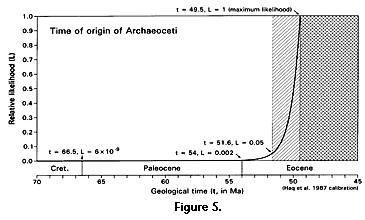TIME OF ORIGIN OF
ARCHAEOCETES
There are approximately 42
independently sampled sites yielding archaeocete whales
distributed on six continents (Table 1). These range in age from late Priabonian (t3,
ca. 36 Ma) to late Ypresian (t2, ca. 49.5
Ma), for an observed temporal range t2 - t3
= 13.5 m.y. Calculation of ETD from equation 3 yields an expected
temporal range of 14.78 m.y., and adding the difference between
expected and observed ranges to the oldest stratigraphic record
at 49.5 yields a classical 95% confidence limit for the time of
origin of archaeocetes and hence all whales at 50.78 Ma, an
extension of about 1.3 m.y. beyond the earliest stratigraphic
record known to date.
Likelihood calculation of the time
of origin of whales is outlined in the work sheet of Table 2
and shown graphically in
Figure 4. Here the origination volume OTD is successively
incremented by 0.001 units until critical likelihoods l = 0.5 and l = 0.05 are
reached and exceeded. Hypothesized times of origin are
interpolated at 49.99 and 51.64 Ma, respectively, with the
latter, an extension of about 2.1 m.y. beyond the earliest
stratigraphic record, being the likelihood equivalent of a 95%
confidence limit. This limit at 51.64 Ma is almost 1 m.y. earlier
in time than the classical confidence interval of Strauss and Sadler (1989) based on a uniform distribution of
potential fossils. The difference is due to assumptions built
into our geometric model of increasing density and diversity of
whales during their initial diversification and to the
exponentially increasing availability of fossil-bearing
sedimentary rocks in more recent geological times.
 The likelihood function calculated for the
time of origin of Archaeoceti is shown in Figure
5. Both of the confidence
limits calculated here, a 50% limit at 49.99 Ma and a 95% limit
at 51.64 Ma, fall comfortably within the early Eocene on the Haq et al. (1987) time scale used here. Thus we can be
confident, given present evidence, that whales originated in the
early Eocene. Any discovery older than the known temporal range
of archaeocetes would of course extend both the range and the
ages associated with all critical likelihoods.
The likelihood function calculated for the
time of origin of Archaeoceti is shown in Figure
5. Both of the confidence
limits calculated here, a 50% limit at 49.99 Ma and a 95% limit
at 51.64 Ma, fall comfortably within the early Eocene on the Haq et al. (1987) time scale used here. Thus we can be
confident, given present evidence, that whales originated in the
early Eocene. Any discovery older than the known temporal range
of archaeocetes would of course extend both the range and the
ages associated with all critical likelihoods.
 The likelihood function calculated for the
time of origin of Archaeoceti is shown in Figure
5. Both of the confidence
limits calculated here, a 50% limit at 49.99 Ma and a 95% limit
at 51.64 Ma, fall comfortably within the early Eocene on the Haq et al. (1987) time scale used here. Thus we can be
confident, given present evidence, that whales originated in the
early Eocene. Any discovery older than the known temporal range
of archaeocetes would of course extend both the range and the
ages associated with all critical likelihoods.
The likelihood function calculated for the
time of origin of Archaeoceti is shown in Figure
5. Both of the confidence
limits calculated here, a 50% limit at 49.99 Ma and a 95% limit
at 51.64 Ma, fall comfortably within the early Eocene on the Haq et al. (1987) time scale used here. Thus we can be
confident, given present evidence, that whales originated in the
early Eocene. Any discovery older than the known temporal range
of archaeocetes would of course extend both the range and the
ages associated with all critical likelihoods.